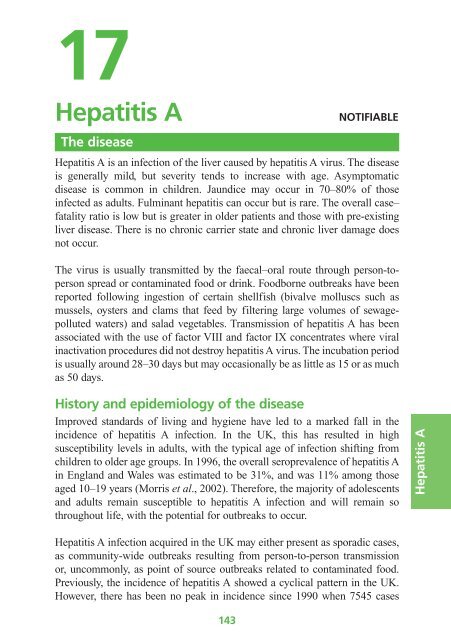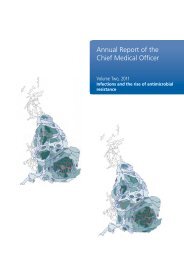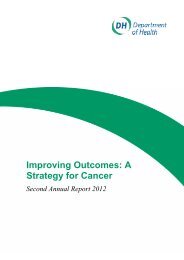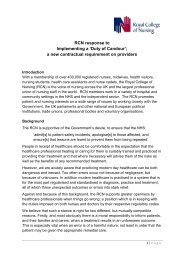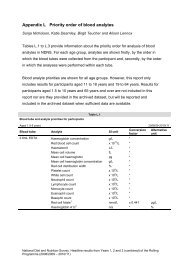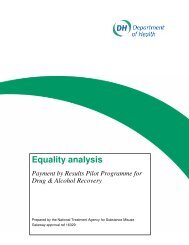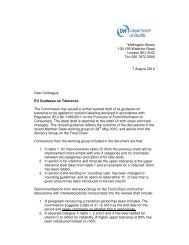Green Book. Chapter 17. Hepatitis A - Department of Health
Green Book. Chapter 17. Hepatitis A - Department of Health
Green Book. Chapter 17. Hepatitis A - Department of Health
Create successful ePaper yourself
Turn your PDF publications into a flip-book with our unique Google optimized e-Paper software.
17<br />
<strong>Hepatitis</strong> A NotifiAble<br />
the disease<br />
<strong>Hepatitis</strong> A is an infection <strong>of</strong> the liver caused by hepatitis A virus. The disease<br />
is generally mild, but severity tends to increase with age. Asymptomatic<br />
disease is common in children. Jaundice may occur in 70–80% <strong>of</strong> those<br />
infected as adults. Fulminant hepatitis can occur but is rare. The overall case–<br />
fatality ratio is low but is greater in older patients and those with pre-existing<br />
liver disease. There is no chronic carrier state and chronic liver damage does<br />
not occur.<br />
The virus is usually transmitted by the faecal–oral route through person-toperson<br />
spread or contaminated food or drink. Foodborne outbreaks have been<br />
reported following ingestion <strong>of</strong> certain shellfish (bivalve molluscs such as<br />
mussels, oysters and clams that feed by filtering large volumes <strong>of</strong> sewagepolluted<br />
waters) and salad vegetables. Transmission <strong>of</strong> hepatitis A has been<br />
associated with the use <strong>of</strong> factor VIII and factor IX concentrates where viral<br />
inactivation procedures did not destroy hepatitis A virus. The incubation period<br />
is usually around 28–30 days but may occasionally be as little as 15 or as much<br />
as 50 days.<br />
History and epidemiology <strong>of</strong> the disease<br />
Improved standards <strong>of</strong> living and hygiene have led to a marked fall in the<br />
incidence <strong>of</strong> hepatitis A infection. In the UK, this has resulted in high<br />
susceptibility levels in adults, with the typical age <strong>of</strong> infection shifting from<br />
children to older age groups. In 1996, the overall seroprevalence <strong>of</strong> hepatitis A<br />
in England and Wales was estimated to be 31%, and was 11% among those<br />
aged 10–19 years (Morris et al., 2002). Therefore, the majority <strong>of</strong> adolescents<br />
and adults remain susceptible to hepatitis A infection and will remain so<br />
throughout life, with the potential for outbreaks to occur.<br />
<strong>Hepatitis</strong> A infection acquired in the UK may either present as sporadic cases,<br />
as community-wide outbreaks resulting from person-to-person transmission<br />
or, uncommonly, as point <strong>of</strong> source outbreaks related to contaminated food.<br />
Previously, the incidence <strong>of</strong> hepatitis A showed a cyclical pattern in the UK.<br />
However, there has been no peak in incidence since 1990 when 7545 cases<br />
143<br />
<strong>Hepatitis</strong> A
<strong>17.</strong>1<br />
<strong>Hepatitis</strong> A<br />
<strong>Hepatitis</strong> A<br />
Total number <strong>of</strong> reports, Scotland<br />
19.1<br />
1000<br />
800<br />
600<br />
400<br />
200<br />
2,500<br />
2,000<br />
been documented in a number <strong>of</strong> other European countries. Transmission<br />
Total number <strong>of</strong> cases<br />
0<br />
with multiple 1,500 anonymous sexual contacts, particularly in ‘darkrooms’ or clubs<br />
1,000<br />
England and Wales<br />
Scotland<br />
1980<br />
1981<br />
1982<br />
1983<br />
1984<br />
1985<br />
1986<br />
1987<br />
1988<br />
1989<br />
1990<br />
1991<br />
1992<br />
1993<br />
1994<br />
1995<br />
1996<br />
1997<br />
1998<br />
1999<br />
2000<br />
2001<br />
2002<br />
2003<br />
2004<br />
2005<br />
Year<br />
Figure <strong>17.</strong>1 Number <strong>of</strong> laboratory-confirmed hepatitis A reports in England and<br />
Wales (1980–2004) and Scotland (1983–2005)<br />
were reported for England and Wales. There were 669 reports in 2004 (HPA,<br />
2005). In Scotland, 26 cases <strong>of</strong> hepatitis A infection were reported to <strong>Health</strong><br />
Protection Scotland (formerly the Scottish Centre for Infection and<br />
Environmental <strong>Health</strong> (SCIEH)) in 2005. This is the lowest annual number <strong>of</strong><br />
acute cases ever recorded. Acute hepatitis A infection had been observed to<br />
decrease steadily in Scotland from 1993 (241 cases) to 2000 (50 cases).<br />
In recent decades in the UK, there has been a number <strong>of</strong> outbreaks <strong>of</strong> hepatitis<br />
A among men who have sex with men (MSM). Similarly, outbreaks have also<br />
appears to be by the faecal–oral route. Some studies have shown associations<br />
(Reintjes et al., 1999; Bell et al., 2001).<br />
Outbreaks <strong>of</strong> hepatitis A have also been documented among injecting drug users<br />
in several countries. An outbreak among injecting drug users in<br />
500<br />
Aberdeen (Roy et al., 2004) contributed to a major increase in the number <strong>of</strong><br />
cases in Scotland in 2001 (148 cases). Recently, outbreaks <strong>of</strong> hepatitis A in<br />
other parts <strong>of</strong> 0 the UK have involved a high proportion <strong>of</strong> individuals with a<br />
history <strong>of</strong> injecting and homeless people living together in hostels and shelters<br />
(O’Donovan et al., 2001; Syed et al., 2003; Year Perrett et al., 2003). Close contact<br />
and poor standards <strong>of</strong> personal hygiene among these groups, with possible<br />
1980<br />
1981<br />
1982<br />
1983<br />
1984<br />
1985<br />
1986<br />
1987<br />
1988<br />
1989<br />
1990<br />
1991<br />
1992<br />
1993<br />
1994<br />
1995<br />
1996<br />
1997<br />
1998<br />
1999<br />
2000<br />
2001<br />
2002<br />
2003<br />
144<br />
8000<br />
7000<br />
6000<br />
5000<br />
4000<br />
3000<br />
2000<br />
1000<br />
0<br />
Total number <strong>of</strong> reports, England and Wales
<strong>Hepatitis</strong> A<br />
faecal contamination <strong>of</strong> shared injecting equipment or drugs, appears to be the<br />
most likely mode <strong>of</strong> transmission (Hutin et al., 2000; Roy et al., 2004).<br />
<strong>Hepatitis</strong> A is more common in countries outside Northern and Western<br />
Europe, North America, Australia and New Zealand. Travel abroad is a<br />
common factor in sporadic cases in the UK. The highest risk areas for UK<br />
travellers are the Indian subcontinent and the Far East, but the risk extends to<br />
Eastern Europe.<br />
the hepatitis A vaccination<br />
There are two products for immunisation against hepatitis A. An<br />
immunoglobulin provides rapid but temporary immunity. The vaccine confers<br />
active immunity but response is not immediate. Vaccines are available as either<br />
monovalent, or combined with either typhoid or hepatitis B.<br />
<strong>Hepatitis</strong> A monovalent vaccines and those combined with either typhoid<br />
or hepatitis B do not contain thiomersal. The vaccines are inactivated, do not<br />
contain live organisms and cannot cause the diseases against which they protect.<br />
Monovalent vaccines<br />
Four monovalent vaccines are currently available, prepared from different<br />
strains <strong>of</strong> the hepatitis A virus; all are grown in human diploid cells (MRC5).<br />
Three (Havrix®, Vaqta ® and Avaxim ®) are adsorbed onto an aluminium<br />
hydroxide adjuvant. The fourth, Epaxal® vaccine, contains formalin-inactivated<br />
hepatitis A particles attached to phospholipid vesicles together with influenza<br />
virus haemagglutinin derived from inactivated influenza virus H1N1 (Gluck et<br />
al., 1992; Loutan et al., 1994). These vaccines can be used interchangeably<br />
(Bryan et al., 2000; Clarke et al., 2001; Beck et al., 2004).<br />
Combined hepatitis A and hepatitis b vaccine<br />
Combined vaccines containing purified inactivated hepatitis A virus and<br />
purified recombinant hepatitis B surface antigen adsorbed onto aluminium<br />
hydroxide (Twinrix®) or aluminium phosphate (Ambirix ®), may be used<br />
when protection against both hepatitis A and hepatitis B infections is<br />
required. If rapid protection against hepatitis A is required for adults, for<br />
example following exposure or during outbreaks, then a single dose <strong>of</strong><br />
monovalent vaccine is recommended. In children under 16 years, a single<br />
dose <strong>of</strong> Ambirix® may also be used for rapid protection against hepatitis A.<br />
Both vaccines contain the higher amount <strong>of</strong> hepatitis A antigen and will<br />
therefore provide hepatitis A protection more quickly than Twinrix.®<br />
145<br />
<strong>Hepatitis</strong> A
<strong>Hepatitis</strong> A<br />
<strong>Hepatitis</strong> A<br />
Combined hepatitis A and typhoid vaccine<br />
Combined vaccines containing purified inactivated hepatitis A virus adsorbed<br />
onto aluminium hydroxide and purified Vi capsular polysaccharide typhoid<br />
vaccine (Hepatyrix® or ViATIM ®) may be used where protection against<br />
hepatitis A and typhoid fever is required (see also <strong>Chapter</strong> 34 on typhoid).<br />
Human normal immunoglobulin<br />
Human normal immunoglobulin (HNIG) is prepared from pooled plasma<br />
derived from blood donations. Use <strong>of</strong> HNIG should be limited to situations<br />
where it may have a definite advantage over vaccine. HNIG can provide<br />
immediate protection, although antibody levels are lower than those eventually<br />
produced by hepatitis A vaccine. There have been no studies directly<br />
comparing the efficacy <strong>of</strong> HNIG with vaccine for prophylaxis in contacts <strong>of</strong><br />
cases. HNIG licensed for use for prophylaxis must have a hepatitis A antibody<br />
level <strong>of</strong> at least 100IU/ml.*<br />
Because <strong>of</strong> a theoretical risk <strong>of</strong> transmission <strong>of</strong> vCJD from plasma products,<br />
HNIG used in the UK is now prepared from plasma sourced from outside the<br />
UK, and supplies are scarce. All donors are screened for HIV, hepatitis B and<br />
C, and all plasma pools are tested for the presence <strong>of</strong> RNA from these viruses.<br />
A solvent detergent inactivation step for envelope viruses is included<br />
in the production process.<br />
Storage<br />
Vaccines should be stored in the original packaging at +2°C to +8°C and<br />
protected from light. All vaccines are sensitive to some extent to heat and cold.<br />
Heat speeds up the decline in potency <strong>of</strong> most vaccines, thus reducing their<br />
shelf life. Effectiveness cannot be guaranteed for vaccines unless they have<br />
been stored at the correct temperature. Freezing may cause increased<br />
reactogenicity and loss <strong>of</strong> potency for some vaccines. It can also cause hairline<br />
cracks in the container, leading to contamination <strong>of</strong> the contents.<br />
HNIG should be stored in the original packaging in a refrigerator at +2°C<br />
to +8°C. These products are tolerant to higher ambient temperatures for<br />
up to one week. They can be distributed in sturdy packaging outside the cold<br />
chain, if needed.<br />
* HNIG for hepatitis A prophylaxis is in short supply and, from time to time, alternative products and doses<br />
may need to be used. For the latest advice, please check with the <strong>Health</strong> Protection Agency<br />
(www.hpa.org.uk) or <strong>Health</strong> Protection Scotland (www.hps.scot.nhs.uk).<br />
146
Presentation<br />
<strong>Hepatitis</strong> A<br />
Vaccine Product Pharmaceutical instructions on handling<br />
presentation before use<br />
Monovalent Havrix Suspension for Shake well to produce<br />
hepatitis A Monodose® injection a slightly opaque, white<br />
vaccines Avaxim®<br />
Vaqta®<br />
Vaqta<br />
Paediatric®<br />
Havrix Junior<br />
Monodose®<br />
suspension<br />
Epaxal® Emulsion for Check for any<br />
injection particulate matter<br />
Combined Twinrix Adult® Suspension Shake the vaccine well<br />
hepatitis A Twinrix for injection to obtain a slightly<br />
and b vaccine Paediatric® opaque suspension<br />
Ambirix® Suspension for Shake the vaccine well<br />
injection in a to obtain a slightly<br />
Combined ViATIM®<br />
pre-filled syringe opaque suspension<br />
A dual-chamber Shake to ensure<br />
hepatitis A syringe suspension is fully mixed.<br />
and typhoid containing a The contents <strong>of</strong> the<br />
vaccine cloudy, white two compartments<br />
suspension are mixed as the<br />
and a clear,<br />
colourless<br />
solution<br />
vaccines are injected<br />
Hepatyrix® Slightly opaque Shake the container well<br />
white suspension<br />
for injection<br />
Dosage and schedule<br />
The immunisation regimes for hepatitis A vaccine and for combined hepatitis<br />
A and typhoid vaccine consist <strong>of</strong> a single dose. The standard schedule for the<br />
combined hepatitis A and hepatitis B vaccine depends on the product. For<br />
Twinrix® the schedule consists <strong>of</strong> three doses, the first on the elected date, the<br />
second one month later and the third six months after the first dose. For<br />
Ambirix® the schedule consists <strong>of</strong> two doses, the first administered on the<br />
elected date and the second between six and twelve months after the first dose.<br />
147<br />
<strong>Hepatitis</strong> A
<strong>Hepatitis</strong> A<br />
<strong>Hepatitis</strong> A<br />
An accelerated schedule <strong>of</strong> Twinrix Adult ® at 0, 7 and 21 days may be used<br />
when early protection against hepatitis B is required (e.g. for travellers<br />
departing within one month).<br />
Dosage for monovalent hepatitis A immunisation<br />
Vaccine product Ages Dose Volume<br />
Havrix Monodose® 16 years or over<br />
Havrix Junior<br />
1440 ELISA units 1.0ml<br />
Monodose® One to 15 years 720 ELISA units 0.5ml<br />
Avaxim® 16 years or over 160 antigen units 0.5ml<br />
Vaqta Paediatric® One to 17 years ~25 units 0.5ml<br />
Epaxal® One year or over 500 RIA units 0.5ml<br />
Dosage <strong>of</strong> combined hepatitis A and typhoid vaccines<br />
Vaccine<br />
product<br />
Ages Dose HAV Dose Vi P ty Volume<br />
Hepatyrix® 15 years<br />
or over<br />
1440 ELISA units 25µg 1.0ml<br />
ViATIM® 16 years<br />
or over<br />
160 antigen units 25µg 1.0ml<br />
Dosage <strong>of</strong> combined hepatitis A and hepatitis b vaccines<br />
Vaccine<br />
product<br />
Twinrix<br />
Adult®<br />
Twinrix<br />
Paediatric®<br />
Ages Dose HAV Dose HbV Volume<br />
16 years<br />
or over<br />
720 ELISA units 20µg 1.0ml<br />
1 to 15 years 360 ELISA units 10µg 0.5ml<br />
Ambirix ® 1 to 15 years 720 ELISA units 20µg 1.0ml<br />
Dosage <strong>of</strong> HNiG<br />
● 250mg for children under ten years.<br />
● 500mg for those aged ten years or older.<br />
Administration<br />
Vaccines are routinely given into the upper arm or anterolateral thigh.<br />
However, for individuals with a bleeding disorder, vaccines should be given by<br />
deep subcutaneous injection to reduce the risk <strong>of</strong> bleeding.<br />
148
<strong>Hepatitis</strong> A<br />
<strong>Hepatitis</strong> A-containing vaccines can be given at the same time as other<br />
vaccines such as hepatitis B, MMR, MenC, Td/IPV and other travel vaccines.<br />
The vaccines should be given at a separate site, preferably in a different limb.<br />
If given in the same limb, they should be given at least 2.5cm apart (American<br />
Academy <strong>of</strong> Pediatrics, 2003). The site at which each vaccine was given should<br />
be noted in the individual’s records.<br />
HNIG can be administered in the upper outer quadrant <strong>of</strong> the buttock or<br />
anterolateral thigh (see <strong>Chapter</strong> 4). If more than 3ml is to be given to young<br />
children and infants, or more than 5ml to older children and adults, the<br />
immunoglobulin should be divided into smaller amounts and administered at<br />
different sites. HNIG may be administered, at a different site, at the same time<br />
as hepatitis A vaccine.<br />
Disposal<br />
Equipment used for vaccination, including used vials, ampoules, or partially<br />
discharged vaccines should be disposed <strong>of</strong> at the end <strong>of</strong> a session by sealing in<br />
a proper, puncture-resistant ‘sharps’ box according to local authority<br />
regulations and guidance in the technical memorandum 07-01 (<strong>Department</strong> <strong>of</strong><br />
<strong>Health</strong>, 2006).<br />
Recommendations for the use <strong>of</strong> the vaccine<br />
Pre-exposure vaccination<br />
The objective <strong>of</strong> the immunisation programme is to provide two doses <strong>of</strong> a<br />
hepatitis A-containing vaccine at appropriate intervals for all individuals at<br />
high risk <strong>of</strong> exposure to the virus or <strong>of</strong> complications from the disease.<br />
Groups recommended to receive pre-exposure vaccination<br />
People travelling to or going to reside in areas <strong>of</strong> high or<br />
intermediate prevalence<br />
Immunisation with hepatitis A vaccine is recommended for those aged one<br />
year and over travelling to areas <strong>of</strong> moderate or high endemicity, such as the<br />
Indian subcontinent, for prolonged periods, particularly if sanitation and food<br />
hygiene is likely to be poor. Vaccine is also recommended for all individuals<br />
going to reside in or likely to be posted for long periods to hepatitis A<br />
virus-endemic countries.<br />
Although hepatitis A is usually sub-clinical in children, it can be severe and<br />
require hospitalisation. Even children who acquire mild or sub-clinical<br />
hepatitis A may be a source <strong>of</strong> infection to others. The risks <strong>of</strong> disease for<br />
children under one year old are low, and vaccines are not licensed for their use<br />
149<br />
<strong>Hepatitis</strong> A
<strong>Hepatitis</strong> A<br />
<strong>Hepatitis</strong> A<br />
at this age. Care should be taken to prevent exposure to hepatitis A infection<br />
through food and water.<br />
For travellers, vaccine should preferably be given at least two weeks before<br />
departure, but can be given up to the day <strong>of</strong> departure. Although antibodies<br />
may not be detectable for 12–15 days following administration <strong>of</strong> monovalent<br />
hepatitis A vaccine, the vaccine may provide some protection before antibodies<br />
can be detected using current assays.<br />
Immunisation is not considered necessary for individuals travelling to or going<br />
to reside in Northern or Western Europe (including Spain, Portugal and Italy),<br />
or North America, Australia or New Zealand. HNIG is no longer recommended<br />
for travel prophylaxis. Country-by-country recommendations for hepatitis A<br />
and other travel vaccines are given in <strong>Health</strong> information for overseas travel<br />
(www.nathnac.org).<br />
Patients with chronic liver disease<br />
Although patients with chronic liver disease may be at no greater risk <strong>of</strong><br />
acquiring hepatitis A infection, it can produce a more serious illness in these<br />
patients (Akriviadis and Redeker, 1989; Keefe, 1995). Immunisation against<br />
hepatitis A is therefore recommended for patients with severe liver disease <strong>of</strong><br />
whatever cause. Vaccine should also be considered for individuals with chronic<br />
hepatitis B or C infection and for those with milder forms <strong>of</strong> liver disease.<br />
Patients with haemophilia<br />
As standard viral inactivation processes may not be effective against hepatitis<br />
A, patients with haemophilia who are receiving plasma-derived clotting factors<br />
should be immunised against hepatitis A. Patients with haemophilia should be<br />
immunised subcutaneously.<br />
Men who have sex with men<br />
MSM with multiple sexual partners need to be informed about the risks <strong>of</strong><br />
hepatitis A, and about the need to maintain high standards <strong>of</strong> personal hygiene.<br />
Immunisation should be <strong>of</strong>fered to such individuals, particularly during<br />
periods when outbreaks are occurring.<br />
Injecting drug users<br />
<strong>Hepatitis</strong> A immunisation is recommended for injecting drug users and can be<br />
given at the same time as hepatitis B vaccine, as separate or combined<br />
preparations.<br />
150
Individuals at occupational risk<br />
<strong>Hepatitis</strong> A vaccination is recommended for the following groups:<br />
<strong>Hepatitis</strong> A<br />
● laboratory workers: individuals who may be exposed to hepatitis A in<br />
the course <strong>of</strong> their work, in microbiology laboratories and clinical<br />
infectious disease units, are at risk and must be protected.<br />
● staff <strong>of</strong> some large residential institutions: outbreaks <strong>of</strong> hepatitis A<br />
have been associated with large residential institutions for those with<br />
learning difficulties. Transmission can occur more readily in such<br />
institutions and immunisation <strong>of</strong> staff and residents is appropriate.<br />
Similar considerations apply in other institutions where standards <strong>of</strong><br />
personal hygiene among clients or patients may be poor.<br />
● sewage workers: raw, untreated sewage is frequently contaminated with<br />
hepatitis A. A UK study to evaluate this risk showed that frequent<br />
occupational exposure to raw sewage was an independent risk factor for<br />
hepatitis A infection (Brugha et al., 1998). Immunisation is, therefore,<br />
recommended for workers at risk <strong>of</strong> repeated exposure to raw sewage,<br />
who should be identified following a local risk assessment.<br />
● people who work with primates: vaccination is recommended for those<br />
who work with primates that are susceptible to hepatitis A infection.<br />
<strong>Hepatitis</strong> A vaccination may be considered under certain circumstances for:<br />
● food packagers and handlers: food packagers or food handlers in the<br />
UK have not been associated with transmission <strong>of</strong> hepatitis A sufficiently<br />
<strong>of</strong>ten to justify their immunisation as a routine measure. Where a case<br />
or outbreak occurs, advice should be sought from the local health<br />
protection unit (HPU)<br />
● staff in day-care facilities: infection in young children is likely to be<br />
sub-clinical, and those working in day-care centres and other settings<br />
with children who are not yet toilet trained may be at increased risk<br />
(Severo et al., 1997). Under normal circumstances, the risk <strong>of</strong><br />
transmission to staff and children can be minimised by careful attention<br />
to personal hygiene. However, in the case <strong>of</strong> a well-defined community<br />
outbreak, such as in a pre-school nursery, the need for immunisation <strong>of</strong><br />
staff and children should be discussed with the local HPU<br />
● healthcare workers: most healthcare workers are not at increased risk<br />
<strong>of</strong> hepatitis A and routine immunisation is not indicated.<br />
Post-exposure immunisation<br />
Either passive or active immunisation, or a combination <strong>of</strong> the two, is<br />
available for the management <strong>of</strong> contacts <strong>of</strong> cases and for outbreak control.<br />
151<br />
<strong>Hepatitis</strong> A
<strong>Hepatitis</strong> A<br />
<strong>Hepatitis</strong> A<br />
There have been no trials directly comparing the efficacy <strong>of</strong> hepatitis A<br />
vaccine alone against HNIG in the management <strong>of</strong> contacts. HNIG is<br />
preferred when protection is required in a shorter time than it takes for a<br />
protective antibody response to the vaccine. Vaccine and HNIG may be given<br />
at the same time, but in different sites, when both rapid and prolonged<br />
protection is required. A single dose <strong>of</strong> monovalent hepatitis A vaccine will<br />
provide more rapid protection than the combined preparations where more<br />
than one dose is required.<br />
HNIG has a proven record in providing prophylaxis for contacts <strong>of</strong> cases <strong>of</strong><br />
acute hepatitis A. HNIG will protect against hepatitis A infection if administered<br />
within 14 days <strong>of</strong> exposure, and may modify disease if given after that time<br />
(Winokur and Stapleton, 1992). Protection lasts for four to six months.<br />
There is some evidence that vaccine may be effective in preventing infection<br />
in contacts <strong>of</strong> cases, provided it can be given soon enough after the onset <strong>of</strong><br />
symptoms in the index case. A study in Naples (Sagliocca et al., 1999) showed<br />
hepatitis A vaccine had a 79% protective efficacy in household contacts <strong>of</strong><br />
people with sporadic infection, where 56% <strong>of</strong> contacts received vaccine within<br />
four days <strong>of</strong> onset <strong>of</strong> symptoms in the index cases, and all within eight days.<br />
If vaccine is to be used in preference to HNIG for prophylaxis <strong>of</strong> contacts,<br />
cases <strong>of</strong> acute hepatitis A will need to be diagnosed and reported to public<br />
health <strong>of</strong>ficials quickly enough to allow administration <strong>of</strong> vaccine within one<br />
week <strong>of</strong> onset.<br />
Contacts <strong>of</strong> cases <strong>of</strong> hepatitis A infection<br />
<strong>Hepatitis</strong> A vaccine should be given to previously unvaccinated contacts <strong>of</strong><br />
cases <strong>of</strong> hepatitis A with onset <strong>of</strong> jaundice within the last week. When the<br />
interval is longer, HNIG should be used, particularly for older people, given the<br />
greater severity <strong>of</strong> disease in this age group. Further guidance on the<br />
management <strong>of</strong> contacts is available in ‘Guidelines for the control <strong>of</strong> hepatitis<br />
A virus infection’ (Crowcr<strong>of</strong>t et al., 2001).<br />
Prophylaxis restricted to household and close contacts may be relatively<br />
ineffective in controlling further spread. If given to a wider social group <strong>of</strong><br />
recent household visitors (kissing contacts and those who have eaten food<br />
prepared by an index case), spread may be prevented more effectively.<br />
If a food handler develops acute jaundice or is diagnosed clinically or<br />
serologically with hepatitis A infection, the local HPU should be immediately<br />
informed by telephone. This will allow a timely risk assessment <strong>of</strong> whether<br />
152
<strong>Hepatitis</strong> A<br />
other food handlers in the same food preparation area could have been exposed<br />
and should be considered for post-exposure prophylaxis. Rapid serological<br />
confirmation and notification <strong>of</strong> hepatitis A infection will allow an assessment<br />
<strong>of</strong> the possible risks to any customers who can be traced and <strong>of</strong>fered prophylaxis.<br />
Further prophylaxis will not be required in immunocompetent contacts who<br />
have previously received hepatitis A vaccine.<br />
If a contact is at ongoing risk <strong>of</strong> hepatitis A infection because <strong>of</strong> their lifestyle<br />
or any other reason, then they should be <strong>of</strong>fered vaccine irrespective <strong>of</strong><br />
whether they are <strong>of</strong>fered HNIG.<br />
outbreaks<br />
Active immunisation with monovalent hepatitis A vaccine provides longer<br />
duration <strong>of</strong> protection, and will be more effective in prolonged outbreaks, such<br />
as those that may occur among MSM or injecting drug users, where<br />
transmissions may continue after the protective effects <strong>of</strong> HNIG have ceased.<br />
The appropriate approach to the management <strong>of</strong> outbreaks <strong>of</strong> hepatitis A<br />
infection with HNIG and/or hepatitis A vaccine should be discussed with the<br />
local HPU. Further guidance on the management <strong>of</strong> outbreaks is available in<br />
‘Guidelines for the control <strong>of</strong> hepatitis A virus infection’ (Crowcr<strong>of</strong>t et al.,<br />
2001).<br />
Primary immunisation<br />
The primary immunisation course for hepatitis A vaccine and for combined<br />
<strong>Hepatitis</strong> A and typhoid vaccine consists <strong>of</strong> a single dose. For adult combined<br />
hepatitis A and B vaccines (Twinrix®) a primary course consists <strong>of</strong> three doses.<br />
There are two combined hepatitis A and B vaccines suitable for use in children.<br />
A primary course <strong>of</strong> Twinrix consists <strong>of</strong> three doses, whereas Ambirix®<br />
consists <strong>of</strong> two doses at a longer interval. The first dose <strong>of</strong> Ambirix®, however,<br />
provides equivalent protection to a primary course <strong>of</strong> single hepatitis A<br />
vaccine, although protection against hepatitis B is not complete until after the<br />
second dose. Protection from a primary course <strong>of</strong> single or combined vaccines<br />
lasts for at least one year.<br />
Reinforcing immunisation<br />
A booster dose <strong>of</strong> hepatitis A vaccine should be given at six to 12 months after<br />
the initial dose. This results in a substantial increase in the antibody titre and<br />
will give immunity beyond ten years. Until further evidence is available on<br />
153<br />
<strong>Hepatitis</strong> A
<strong>Hepatitis</strong> A<br />
<strong>Hepatitis</strong> A<br />
persistence <strong>of</strong> protective immunity, a further booster at 20 years is indicated<br />
for those at ongoing risk (Van Damme, 2003).<br />
Where a combined hepatitis A and typhoid vaccine has been used to initiate<br />
immunisation, a dose <strong>of</strong> single antigen hepatitis A vaccine will be required six<br />
to 12 months later in order to provide prolonged protection against hepatitis A<br />
infection. Booster doses <strong>of</strong> the typhoid component will be required at three<br />
years.<br />
For individuals who have received combined hepatitis A and B vaccine in an<br />
accelerated schedule, a booster dose is required at one year.<br />
Delayed administration <strong>of</strong> the booster dose<br />
Ideally, the manufacturers’ recommended timing for the administration <strong>of</strong> the<br />
booster dose <strong>of</strong> hepatitis A vaccine should be followed. In practice, and<br />
particularly in infrequent travellers, there may be a delay in accessing this<br />
injection. Studies have shown that successful boosting can occur even when<br />
the second dose is delayed for several years (Landry et al., 2001; Beck et al.,<br />
2003), so a course does not need to be re-started.<br />
Contraindications<br />
There are very few individuals who cannot receive hepatitis A-containing<br />
vaccines. When there is doubt, appropriate advice should be sought from a<br />
consultant paediatrician, immunisation co-ordinator or local HPU rather than<br />
withholding vaccine.<br />
The vaccine should not be given to those who have had:<br />
● a confirmed anaphylactic reaction to a previous dose <strong>of</strong> a hepatitis<br />
A-containing vaccine, or<br />
● a confirmed anaphylactic reaction to any component <strong>of</strong> the vaccine.<br />
Epaxal should not be given to those who have had a confirmed anaphylactic<br />
hypersensitivity to egg products as a component <strong>of</strong> the vaccine is prepared on<br />
hens’ eggs.<br />
Precautions<br />
Minor illnesses without fever or systemic upset are not valid reasons to<br />
postpone immunisation.<br />
If an individual is acutely unwell, immunisation may be postponed until they<br />
154
<strong>Hepatitis</strong> A<br />
have fully recovered. This is to avoid confusing the differential diagnosis <strong>of</strong><br />
any acute illness by wrongly attributing any signs or symptoms to the adverse<br />
effects <strong>of</strong> the vaccine.<br />
HNiG<br />
When HNIG is being used for prevention <strong>of</strong> hepatitis A, it must be remembered<br />
that it may interfere with the subsequent development <strong>of</strong> active immunity from<br />
live virus vaccines. If immunoglobulin has been administered first, then an<br />
interval <strong>of</strong> three months should be observed before administering a live virus<br />
vaccine. If immunoglobulin has been given within three weeks <strong>of</strong> administering<br />
a live vaccine, then the vaccine should be repeated three months later. This<br />
does not apply to yellow fever vaccine since HNIG does not contain significant<br />
amounts <strong>of</strong> antibodies to this virus.<br />
Pregnancy and breast-feeding<br />
<strong>Hepatitis</strong> A-containing vaccines may be given to pregnant women when<br />
clinically indicated. There is no evidence <strong>of</strong> risk from vaccinating pregnant<br />
women or those who are breast-feeding with inactivated viral or bacterial<br />
vaccines or toxoids (Plotkin and Orenstein, 2004).<br />
immunosuppression and HiV infection<br />
Individuals with immunosuppression and HIV infection can be given hepatitis<br />
A-containing vaccines (Bodsworth et al., 1997; Kemper et al., 2003) although<br />
seroconversion rates and antibody titre may be lower and appear to be related<br />
to the individual’s CD4 count at the time <strong>of</strong> immunisation (Neilsen et al., 1997;<br />
Kemper et al., 2003). Re-immunisation should be considered and specialist<br />
advice may be required.<br />
Further guidance is provided by the Royal College <strong>of</strong> Paediatrics and<br />
Child <strong>Health</strong> (www.rcpch.ac.uk), the British HIV Association (BHIVA)<br />
Immunisation guidelines for HIV-infected adults (BHIVA, 2006) and the<br />
Children’s HIV Association <strong>of</strong> UK and Ireland (CHIVA) immunisation<br />
guidelines (www.bhiva.org/chiva).<br />
Adverse reactions<br />
Adverse reactions to hepatitis A vaccines are usually mild and confined to the<br />
first few days after immunisation. The most common reactions are mild,<br />
transient soreness, erythema and induration at the injection site. A small,<br />
painless nodule may form at the injection site; this usually disappears and is <strong>of</strong><br />
no consequence.<br />
155<br />
<strong>Hepatitis</strong> A
<strong>Hepatitis</strong> A<br />
<strong>Hepatitis</strong> A<br />
General symptoms such as fever, malaise, fatigue, headache, nausea and loss<br />
<strong>of</strong> appetite are also reported less frequently.<br />
HNIG is well tolerated. Very rarely, anaphylactoid reactions occur in<br />
individuals with hypogammaglobulinaemia who have IgA antibodies, or those<br />
who have had an atypical reaction to blood transfusion.<br />
Serious, suspected adverse reactions to vaccines should be reported through<br />
the Yellow Card scheme.<br />
No cases <strong>of</strong> blood-borne infection acquired through immunoglobulin<br />
preparations designed for intramuscular use have been documented in any<br />
country.<br />
Supplies<br />
<strong>Hepatitis</strong> A vaccine<br />
● Avaxim ® (adolescents and adults aged 16 years or over)<br />
● Vaqta Paediatric ® (children and adolescents from one up to 17 years)<br />
These vaccines are available from San<strong>of</strong>i Pasteur MSD<br />
(Tel: 0800 0855511).<br />
● Havrix Monodose ® (adults aged 16 years or over)<br />
● Havrix Junior Monodose ® (children and adolescents from one up to<br />
15 years)<br />
These vaccines are available from GlaxoSmithKline<br />
(Tel: 0808 1009997).<br />
● Epaxal ® (adults and children from one year <strong>of</strong> age)<br />
This vaccine is available from Crucell<br />
(Tel: 084 4800 3907).<br />
Combined vaccines<br />
● ViATIM ® (adults and adolescents aged 16 years or over) (with typhoid)<br />
This vaccine is available from San<strong>of</strong>i Pasteur MSD.<br />
● Ambirix® (children/adolescents aged one to 15 years) (with hepatitis B)<br />
● Twinrix Adult ® (aged 16 years or over) (with hepatitis B)<br />
● Twinrix Paediatric ® (children/adolescents aged one to 15 years)<br />
(with hepatitis B)<br />
156
● Hepatyrix ® (adults and adolescents aged 15 years or over)<br />
(with typhoid)<br />
These<br />
vaccines are available from GlaxoSmithKline.<br />
immunoglobulin<br />
HNIG is available for contacts <strong>of</strong> cases and control <strong>of</strong> outbreaks<br />
only from:<br />
England and Wales:<br />
<strong>Health</strong> Protection Agency<br />
Centre for Infections<br />
(Tel: 020 8200 6868).<br />
Scotland:<br />
<strong>Health</strong> Protection Scotland<br />
Glasgow<br />
(Tel: 0141 300 1100).<br />
Northern Ireland:<br />
Northern Ireland Public <strong>Health</strong> Laboratory<br />
Belfast City Hospital<br />
(Tel: 02890 329241).<br />
HNIG is produced by the Scottish National Blood Transfusion Service<br />
(Tel: 0131 536 5797 or 5763).<br />
<strong>Hepatitis</strong> A<br />
References<br />
Akriviadis EA and Redeker AG (1989) Fulminant hepatitis A in intravenous drug users with<br />
chronic liver disease. Ann Intern Med 110: 838–9.<br />
American Academy <strong>of</strong> Pediatrics (2003) Active immunization. In: Pickering LK (ed.) Red<br />
<strong>Book</strong>: 2003 Report <strong>of</strong> the Committee on Infectious Diseases, 26th edition. Elk Grove<br />
Village, IL: American Academy <strong>of</strong> Pediatrics, p. 33.<br />
Beck BR, Hatz C, Bronnimann R et al. (2003) Successful booster antibody response up to<br />
54 months after single primary vaccination with virosome-formulated, aluminium-free<br />
hepatitis A vaccine. Clin Infect Dis 37: 126–8.<br />
Beck BR, Hatz CFR, Loutan L et al. (2004) Immunogenicity <strong>of</strong> booster vaccination with a<br />
virosomal hepatitis A vaccine after primary immunisation with an aluminium-adsorbed<br />
hepatitis A vaccine. J Travel Med 11: 201–207.<br />
157<br />
<strong>Hepatitis</strong> A
<strong>Hepatitis</strong> A<br />
<strong>Hepatitis</strong> A<br />
Bell A, Ncube F, Hansell A et al. (2001) An outbreak <strong>of</strong> hepatitis A among young men<br />
associated with having sex in public places. Commun Dis Public <strong>Health</strong> 4(3): 163–70.<br />
Bodsworth NJ, Neilson GA and Donovan B (1997) The effect <strong>of</strong> immunisation with<br />
inactivated hepatitis A vaccine on the clinical course <strong>of</strong> HIV-1 infection: one-year followup.<br />
AIDS 11: 747–9.<br />
British HIV Association (2006) Immunisation guidelines for HIV-infected adults. www.<br />
bhiva.org/pdf/2006/Immunisation506.pdf<br />
Brugha R, Heptonstall J, Farrington P et al. (1998) Risk <strong>of</strong> hepatitis A infection in sewage<br />
workers. Occup Environ Med 55: 567–9.<br />
Bryan JP, Henry CH, H<strong>of</strong>fman AG et al. (2000) Randomized, cross-over, controlled<br />
comparison <strong>of</strong> two inactivated hepatitis A vaccines. Vaccine 19: 743–50.<br />
Clarke P, Kitchin N and Souverbie F (2001) A randomised comparison <strong>of</strong> two inactivated<br />
hepatitis A vaccines, Avaxim and Vaqta, given as a booster to subjects primed with Avaxim.<br />
Vaccine 19: 4429–33.<br />
Crowcr<strong>of</strong>t NS, Walsh B, Davison KL et al. (2001) Guidelines for the control <strong>of</strong> hepatitis A<br />
infection. Commun Dis Public <strong>Health</strong> 4: 213–27.<br />
<strong>Department</strong> <strong>of</strong> <strong>Health</strong> (2001) <strong>Health</strong> information for overseas travel, 2nd edition.<br />
London: TSO.<br />
<strong>Department</strong> <strong>of</strong> <strong>Health</strong> (2006) <strong>Health</strong> technical memorandum 07-01: Safe management <strong>of</strong><br />
healthcare waste. www.dh.gov.uk/en/Publicationsandstatistics/Publications/<br />
PublicationsPolicyAndGuidance/DH_063274. Accessed: Nov. 2008.<br />
Gluck R, Mischler R, Brantschen S et al. (1992) Immunopotentiating reconstructed influenza<br />
virus virosome (IRIV) vaccine delivery system for immunisation against<br />
hepatitis A. J Clin Invest 90: 2491–5.<br />
<strong>Health</strong> Protection Agency (2005) Laboratory reports <strong>of</strong> hepatitis A in England and Wales:<br />
2004. Commun Dis Rep CDR Wkly [serial online] 15 (34). www.hpa.org.uk/cdr/<br />
archives/2005/cdr3405.pdf.<br />
Henning KJ, Bell E, Braun J and Barkers ND (1995) A community-wide outbreak<br />
<strong>of</strong> hepatitis A: risk factors for infection among homosexual and bisexual men. Am J Med<br />
99: 132–6.<br />
Hutin YJ, Sabin KM, Hutwager LC et al. (2000) Multiple modes <strong>of</strong> hepatitis A virus<br />
transmission among methamphetamine users. Am J Epidemiol 152: 186–92.<br />
Keefe EB (1995) Is hepatitis A more severe in patients with chronic hepatitis B and other<br />
chronic liver diseases? Am J Gastroenterol 90: 201–5.<br />
Kemper CA, Haubrich R, Frank I et al. (2003) Safety and immunogenicity <strong>of</strong> hepatitis A<br />
vaccine in human immunodeficiency virus-infected patients: a double blind, randomised,<br />
placebo-controlled trial. J Infect Dis 187: 1327–31.<br />
158
<strong>Hepatitis</strong> A<br />
Landry P, Tremblay S, Darioli R et al. (2001) Inactivated hepatitis A vaccine booster given<br />
at or after 24 months after the primary dose. Vaccine 19: 399–402.<br />
Loutan L, Bovier P, Althaus B et al. (1994) Inactivated virosome hepatitis A vaccine. Lancet<br />
343: 322–4.<br />
Mele A, Sagliocca L, Palumbo F et al. (1991) Travel-associated hepatitis A: effect <strong>of</strong> place<br />
<strong>of</strong> residence and country visited. J Public <strong>Health</strong> Med 13: 256–9.<br />
Morris MC, Gay NJ, Hesketh LM et al. (2002) The changing epidemiological pattern <strong>of</strong><br />
hepatitis A in England and Wales. Epidemiol Infect. 128: 457–63.<br />
Neilsen GA, Bodsworth NJ and Watts N (1997) Response to hepatitis A vaccination in<br />
human immunodeficiency virus-infected and -uninfected homosexual men. J Infect Dis<br />
176: 1064–7.<br />
O’Donovan D, Cooke RPD, Joce R et al. (2001) An outbreak <strong>of</strong> hepatitis A among<br />
injecting drug users. Epidemiol Infect 127: 469–73.<br />
Perrett K, Granerod J, Crowcr<strong>of</strong>t N et al. (2003) Changing epidemiology <strong>of</strong> hepatitis A:<br />
should we be doing more to vaccinate injecting drug users? Commun Dis Public <strong>Health</strong><br />
6: 97–100.<br />
Plotkin SA and Orenstein WA (eds) (2004) Vaccines, 4th edition. Philadelphia: WB<br />
Saunders Company.<br />
Reid TM and Robinson HG (1987) Frozen raspberries and hepatitis A. Epidemiol Infect<br />
98: 109–12.<br />
Reintjes R, Bosman A, de Zwart O et al. (1999) Outbreak <strong>of</strong> hepatitis A in Rotterdam<br />
associated with visits to ‘darkrooms’ in gay bars. Commun Dis Public <strong>Health</strong> 2(1): 43–6.<br />
Roy K, Howie H, Sweeney C et al. (2004) <strong>Hepatitis</strong> A virus and injecting drug misuse in<br />
Aberdeen, Scotland: a case-control study. J Viral Hepat 11: 277–82.<br />
Sagliocca L, Amoroso P, Str<strong>of</strong>folini T et al. (1999) Efficacy <strong>of</strong> hepatitis A vaccine in<br />
prevention <strong>of</strong> secondary hepatitis A infection: a randomised trial. Lancet 353: 1136–9.<br />
Severo CA, Abensur P, Buisson Y et al. (1997) An outbreak <strong>of</strong> hepatitis A in a French<br />
day-care center and efforts to combat it. Eur J Epidemiol 13: 139–44.<br />
Syed NA, Hearing SD, Shaw IS et al. (2003) Outbreak <strong>of</strong> hepatitis A in the injecting drug<br />
user and homeless populations in Bristol: control by a targeted vaccination programme and<br />
possible parenteral transmission. Eur J Gastroenterol Hepatol 15: 901–6.<br />
Van Damme P, Banatvala J. Fay O et al. (2003) <strong>Hepatitis</strong> A booster vaccination: is there a<br />
need? Lancet 362: 1065–71.<br />
Winokur PL and Stapleton JT (1992) Immunoglobulin prophylaxis for hepatitis A. Clin<br />
Infect Dis 14: 580–6.<br />
159<br />
<strong>Hepatitis</strong> A


